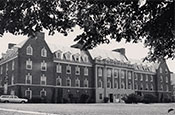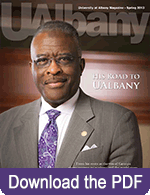Ask Geoff
By Geoff Williams, University Archivist
Home Sweet Home
ince the 19th century, students have lived in a variety of housing while earning their degrees at UAlbany and its predecessor institutions.
In the late 1800s and early 1900s, New York State Normal School and Normal College students were assigned housing approved by the principal/president and the faculty. Most women boarded with families. Men, often three or four to a room, generally lived in rooming houses.
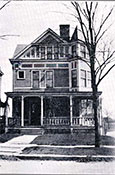
The Psi Gamma house was located at 121 Lake Avenue in Albany.
The first sororities and fraternities, established during the same time period, soon offered new housing options, renting or purchasing homes for the use of their members. According to the 1921 Student Handbook, the Normal College had seven sororities, and six had houses. South Lake Avenue was one of the most popular housing locations, with at least 14 student homes located there from the 1920s through the ’60s. Greek houses were also well represented along Madison Avenue and on Ontario, Quail and State streets. After World War II, Beta Zeta Sorority and the Potter Club both had large houses on State Street.
By 1918, student housing was supplemented by Syddum Hall, a private residence originally at 390 Madison, and Newman Hall on Elm Street. The latter, which moved to 741 Madison in 1921, would remain a home for Catholic women students until the mid-1960s.
Fraternities, sororities and private groups, however, couldn’t provide adequate housing for the students – a fact Abram Brubacher, president of what was by then the New York State College for Teachers (NYSCT), recognized early on. After appealing unsuccessfully to the state to build dormitories, Brubacher turned to the Alumni Association in the 1920s. Graduates Anna E. Pierce, first dean of Women, and John Manville Sayles, who would succeed Brubacher as president, led the effort. Pierce wrote a guide advocating the instructional worth of dormitories in educating women students in values essential to future teachers and administrators.
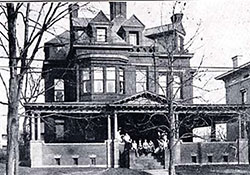
Newman Hall, opened on Elm Street, moved to 741 Madison Ave by 1921. The building, which had its own chapel, would remain a home for Catholic women students until the mid-1960s.
Supported primarily by modestly paid teachers who made pledges payable in $20 installments each Jan. 1 for five years, the fundraising endeavor raised $600,000. A dormitory for women opened in 1935; one for male students opened six years later. Both were constructed and owned by the Alumni Association and financed through its fundraising arm, the Benevolent Association. The residences were named in 1941: the women’s for Pierce; the men’s for Sayles.
The buildings’ interiors were splendid. Public rooms featured striking moldings, woodwork and lighting that evoked the atmosphere of English country homes. Like most student housing built before the 1990s, private rooms were Spartan, furnished with beds, desks, closet space and possibly an electrical outlet. Communal baths were located in hallways.
In 1944, the New York State Dormitory Authority was created, and the first NYSCT-owned, state-funded dorm opened in 1951 on what is now Alumni Quadrangle. Ironically, it was named for Brubacher.
|
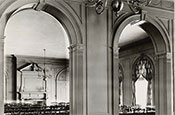 The dining room at Pierce Hall featured beautiful woodwork and lighting. |
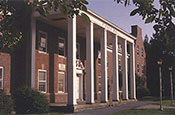 A 14-year fundraising campaign financed the construction of Pierce Hall for women and a men's residence later known as Sayles Hall. Pierce Hall, above, opened in 1935, during the Great Depression. |
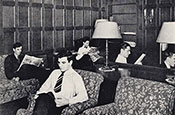 Men and women students dressed for dinner - at least on the weekends. Here, Sayles Hall residens await dinner, which will be served in the adjacent dining room. |
With the Alumni Association’s purchase of property at Alumni Quad came housing that served as cottage dormitories until it was demolished to make way for construction of residence halls. Enrollment reached 2,500 students by the late 1950s, and the Benevolent Association and the Faculty Student Association purchased or rented buildings near the site, transforming them all into cottage dorms. The Farrell Mansion, located on the west side of Thurlow Terrace and a bequest to the school; the Cooper Mansion, which stood where the downtown campus parking lot is now located; and Van Derzee Hall at the corner of Sprague and Spring streets, were palatial. St. Mary’s Park, a converted World War II barracks across Partridge Street, provided more modest accommodations.
In 1960, then-Gov. Nelson Rockefeller decided that, owing to the excellence of its undergraduate teaching and master’s programs, NYSCT would be designated one of four State University of New York University Centers. By 1970, 10,000 students were enrolled at Albany, and the purchase and rental of dorms around what would become the downtown campus continued.
In the Fall 2013 UAlbany, “Ask Geoff” will examine student housing at the University during the past 50 years.
- UAlbany Magazine
Spring 2013 - Cover Story
- Features
- Departments
- The Carillon
- Past Issues

